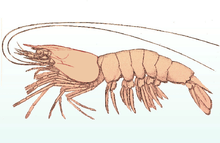Litopenaeus setiferus
| Litopenaeus setiferus | |
|---|---|
 | |
| Scientific classification | |
| Kingdom: | Animalia |
| Phylum: | Arthropoda |
| Subphylum: | Crustacea |
| Class: | Malacostraca |
| Order: | Decapoda |
| Family: | Penaeidae |
| Genus: | Litopenaeus |
| Species: | L. setiferus |
| Binomial name | |
| Litopenaeus setiferus (Linnaeus, 1767) | |
| Synonyms | |
| |


Litopenaeus setiferus (formerly Penaeus setiferus, and known by various common names including white shrimp, gray shrimp, lake shrimp, green shrimp, green-tailed shrimp, blue-tailed shrimp, rainbow shrimp, Daytona shrimp, common shrimp, southern shrimp, and, in Mexico, camaron blanco) is a species of prawn found along the Atlantic coast of North America and in the Gulf of Mexico.[1] It was the subject of the earliest shrimp fishery in the United States.
Distribution
The range of L. setiferus extends from Fire Island, New York to Ciudad Campeche, Mexico.[1] It requires warm water, and is unable to survive below 3 °C (37 °F), with appreciable growth only occurring at temperatures over 20 °C (68 °F).[1]
Description
Litopenaeus setiferus may reach a total length (excluding antennae) of 197 mm (7.8 in), with females being larger than males.[1] The antennae may be up to three times the length of the body, which is bluish white with a tinge of pink on the sides, and black spots.[2] The pleopods are often redder, and the uropods and telson are green.[2] The rostrum is long and thin, with 5–11 teeth on the upper edge and 2 on the lower edge, and continues along the carapace as a dorsal carina (ridge).[2] Deep grooves alongside the carine separate the related species Farfantepenaeus aztecus ("brown shrimp") and Farfantepenaeus duorarum ("pink shrimp") from L. setiferus.[1][2]
Ecology
Litopenaeus setiferus lives in estuaries and from the littoral zone to water with a depth of 100 feet (30 m) in the Atlantic, or up to 260 ft (79 m) in the Gulf of Mexico. [2] Litopenaeus setiferus is an omnivore; in Lake Pontchartrain, it feeds chiefly on the seagrass Vallisneria americana and detritus.[3] Many aquatic animals feed on L. setiferus, including fish such as red drum (Sciaenops ocellatus) and turtles such as the loggerhead sea turtle (Caretta caretta).[3]
Life cycle
Spawning in L. setiferus occurs while the water is warm, between the increase in water temperatures in the spring and the sudden decline in temperature in the fall.[1] It generally occurs within 9 km (5.6 mi) of the shoreline, in water less than 9 m (30 ft) deep in the Atlantic, or 8–31 m (26–102 ft) deep in the Gulf of Mexico.[1] Males attach a spermatophore to the females, which is then used to fertilize the eggs as they are released.[1] Each female releases 500,000–1,000,000 purplish eggs, each 0.2–0.3 mm (0.008–0.012 in) across, which sink to the bottom of the water column.[1]
After 10–12 hours, the eggs hatch into nauplius larvae, which are 0.3 mm (0.012 in) long, planktonic and unable to feed.[1] They molt five times to reach the protozoea stage, 1 mm (0.039 in) long. These grow to 2.5 mm (0.098 in) long over two molts, before passing through three molts as a mysis larva.[1] About 15–20 days after hatching, the animals reaches the postlarva stage; in the second postlarval stage, at a length of 7 mm (0.28 in), they begin to enter estuaries and drop down to the substrate.[1]
Spring rains flush the shrimp out into the ocean. In the Eastern United States, shrimp then migrate south towards warmer waters.[4]
Fishery
Subsistence fishing for prawns was carried out by Native Americans along the Atlantic coast.[5] This knowledge was passed on to European settlers,[5] and Litopenaeus setiferus became the subject of the earliest shrimp fishery in the United States, with commercial fishery for L. setiferus starting as early as 1709.[1]
Notes
| External identifiers for Litopenaeus setiferus | |
|---|---|
| Encyclopedia of Life | 128564 |
| ITIS | 551680 |
| NCBI | 64468 |
| WoRMS | 158336 |
| Also found in: FAO, EoLspecies, diArk | |
- 1 2 3 4 5 6 7 8 9 10 11 12 13 Robert J. Muncy (1984). White shrimp (PDF). Species profiles: life histories and environmental requirements of coastal fishes and invertebrates (South Atlantic). United States Fish and Wildlife Service. pp. 1–19. FWS/OBS-82/11.27.
- 1 2 3 4 5 "Litopenaeus setiferus". Field Guide to the Indian River Lagoon. Smithsonian Marine Station at Fort Pierce. Retrieved May 11, 2011.
- 1 2 Christopher D. Davis (July 2009). "A Generalized Food Web for Lake Pontchartrain in Southeastern Louisiana" (PDF). Lake Pontchartrain Basin Foundation. Retrieved May 11, 2011.
|chapter=ignored (help) - ↑ Reed, Matt (December 22, 2011). "Will U.S. fish limits deplete Canaveral's fleet". Florida Today. Melbourne, Florida. pp. 10A.
- 1 2 G. Riekerk. "Commercial Fisheries: Shrimp". Characterization of the Ashepoo-Combahee-Edisto (ACE) Basin, South Carolina. National Oceanic and Atmospheric Administration. Retrieved May 11, 2011.
Other references
- White shrimp NOAA FishWatch. Retrieved 4 November 2012.